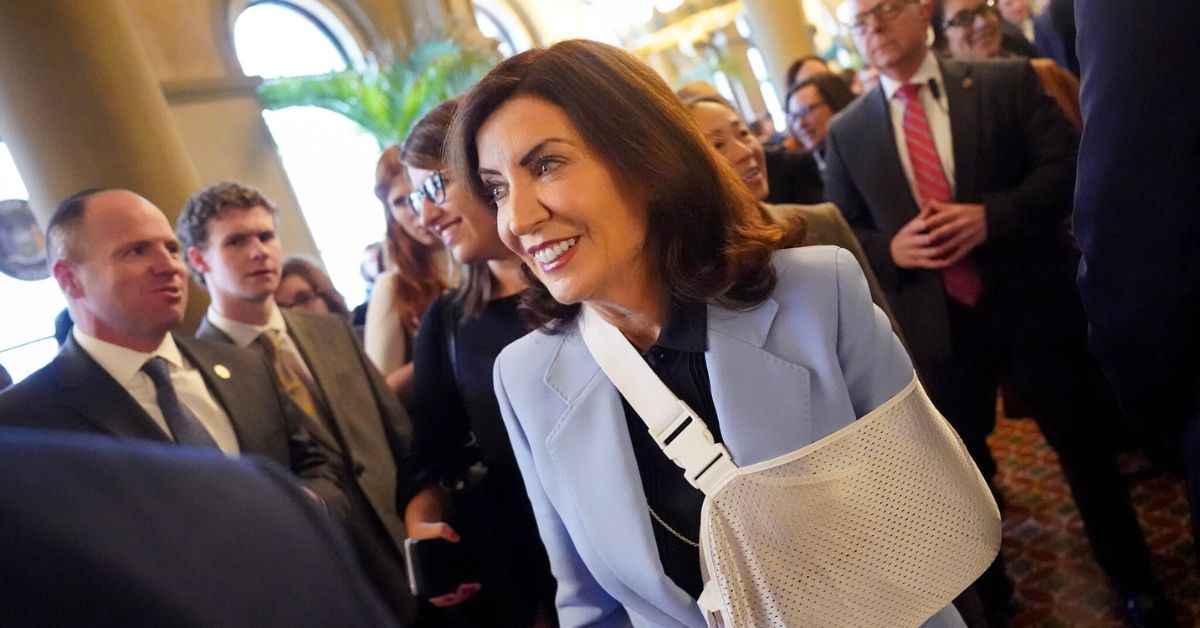New York Governor Kathy Hochul will propose a groundbreaking statewide collaboration in her third State of the State speech. This consortium would unite public and private resources to position New York as a leader in the field of artificial intelligence.
As part of the proposal, Ms. Hochul would allocate $275 million from the state budget to construct a facility that a number of public and private academic institutions, including SUNY and CUNY, would share.
Contributions totaling $25 million would be made by four universities: Columbia, Cornell, New York, and Rensselaer Polytechnic Institute. The project would be called “Empire A.I.” Bloomberg L.P. co-founder and billionaire Thomas Secunda has contributed additional private capital, and the Simons Foundation’s Flatiron Institute, a research facility linked with the foundation, will also be involved.
Ms. Hochul claims that the program would have a physical hub in upstate New York where consortium members will have remote access to the massive processing power needed to operate modern artificial intelligence applications.
While the governor has proposed solutions to issues like medical debt, literacy, and maternal mortality, this one looks to the future. According to Ms. Hochul, this investment will boost the state’s economy for a long time and assist close the gap between tech corporations and academic institutions when it comes to developing artificial intelligence.

“This isn’t just a win for the future of tech — this is a win for the institutions across the state that will benefit from the growth of this technology,” Ms. Hochul made it clear in a statement.
New York’s entry into artificial intelligence development coincides with the emergence of new obstacles for this field of study. In order to create AI systems, scientists feed A.I. models massive volumes of data, the majority of which originates from the internet.
However, concerns regarding the appropriate recipients and purposes of such data have been prompted by lawsuits filed by data owners, including The New York Times.
The state’s Democratic-controlled legislature will consider Ms. Hochul’s proposal alongside other priorities, so she will need to convince them to support it. The impending budget shortfall this year will need careful consideration throughout that talks.
Ms. Hochul has so far rejected the progressive preferred course of action—an increase in taxes on the wealthy—on the grounds that doing so would cause high-income people to flee the state.
Ms. Hochul has so far included a number of massive expenditures in her economic strategy, such as an incentive package worth $5.5 billion to attract Micron’s new facility south of Syracuse, in the hopes that these will secure New York’s position in the technological marketplace.
Notable figures have shown their support for the proposed project: Executive at OpenAI Sam Altman was very supportive of the plan, calling public-private partnerships like this “critical for the development and deployment of safe and beneficial A.I. technologies.”
Speaking on behalf of Tech:NYC—an organization that represents tech giants like Google, Microsoft, and Meta—Julie Samuels stated that the consortium will draw in both academia and businesses looking to recruit top talent.
Because of their access to the expensive data and processing resources needed by AI systems, companies like Google and Microsoft have long dominated the space. Researchers can earn significantly more in private sector than at academic institutions, and tech companies are luring them there because of this advantage.
Columbia University computer science professor and EVPR Jeannette Wing said, “We are, in some sense, unable to compete in a way that we would like to.” The collaboration wouldn’t make the public and private sectors compete on equal footing, but it might open doors to resources that have been out of reach for researchers before.
Businesses nowadays are operating at such a breakneck pace that they can’t afford to plan for the far-off future of this technology. Dr. Wing argued that this is the responsibility of academic institutions, noting that academics have more time and resources to devote to investigating ethical issues than their business counterparts.
Others were skeptical of the state’s proposal because it would necessitate developing its own cloud computing infrastructure from the ground up, rather than relying on preexisting platforms like Amazon or Google. This would be an extremely challenging and risky undertaking.
“It’s a massive effort,” remarked Oren Etzioni, a former technical director at the Allen Institute for Artificial Intelligence. “Will this be reimagining something old so that it has the New York State or Big Apple stamp on it?” “That could be really concerning.”
One of the main goals of the initiative, according to Ms. Hochul’s team, was to facilitate public-interest collaborative research by challenging the artificial intelligence monopoly of big tech companies.
Supporters of the idea argue that by working together, researchers in disciplines as diverse as urban planning, medicine, and music could explore new avenues of inquiry made possible by artificial intelligence.
“I would prefer that those responsible for weather forecasting have access to more robust computer systems,” stated Kathryn Garcia, director of operations for New York, in an interview given the day prior to the anticipated snowfall that would assault the state.
“I have a forecast that could be ‘maybe nothing’ to ‘maybe a lot,’” she added. “When you’re trying to plan, and be prepared for something, our current weather models aren’t keeping up with where climate change is going.”
If you enjoyed this tech post, you might also be interested in:



